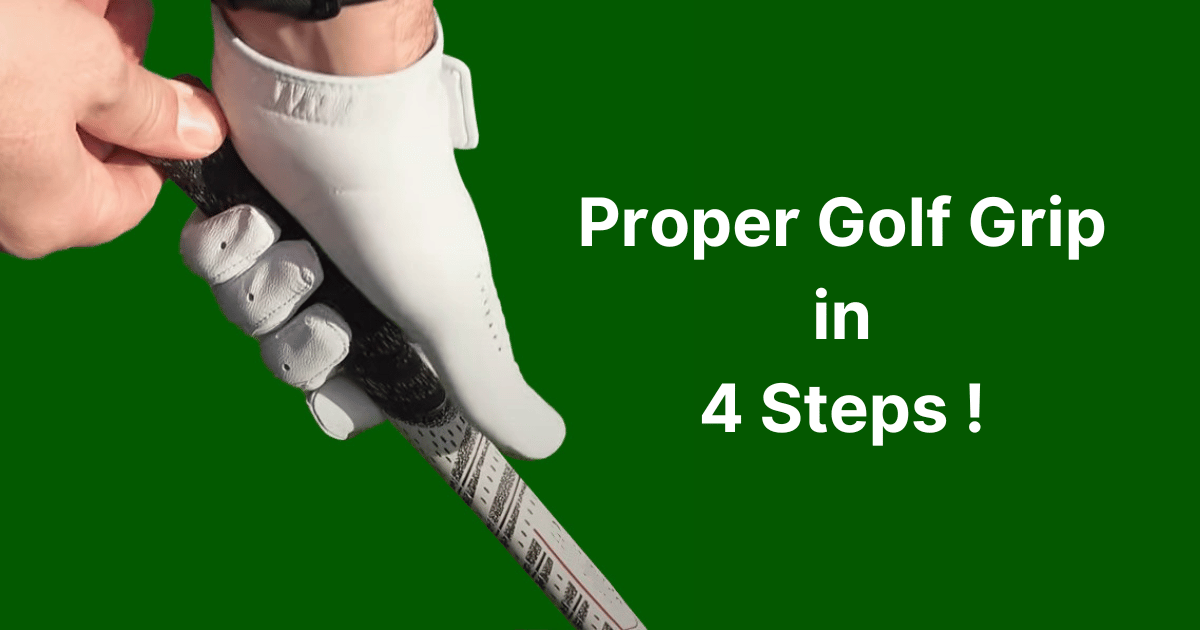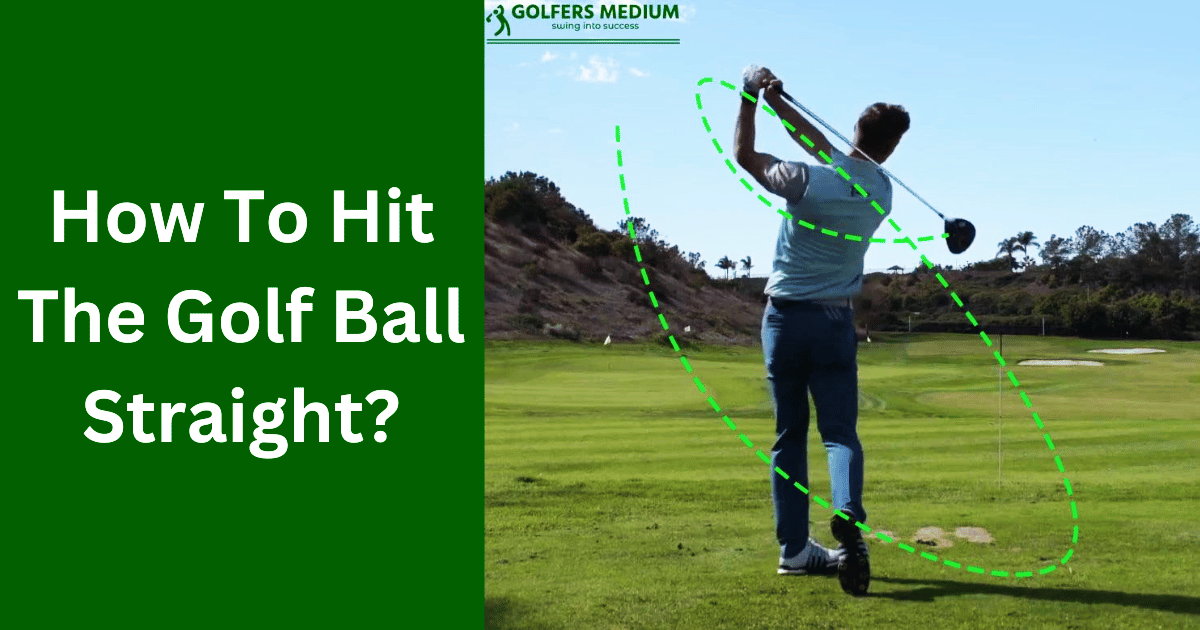To grip a golf club properly, follow these 4 steps:
Step 1
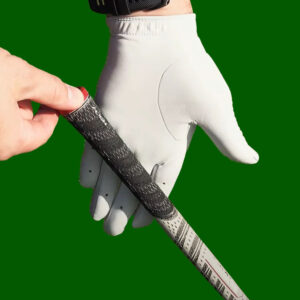
- Place your left hand (for right-handed golfers) on the club handle with your fingers pointing down the shaft.
Step 2

- Wrap your left hand around the grip so that your fingers are comfortably placed on the club. Make sure your left hand is not too far up or down the shaft.
Step 3
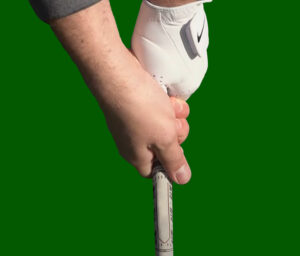
- Place your right hand on the club handle, wrapping your fingers around the left thumb. The right thumb should be placed along the top of the grip, slightly to the left of center.
Step 4
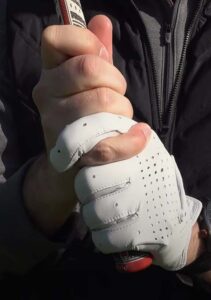
- Interlock your right pinky finger with your left index finger to create a secure connection.
Pro Tips:
- Check that your grip pressure is not too tight or too loose. A good grip pressure should be firm but not so tight that it causes tension in your hands or arms.
- Ensure that your hands are working together as one unit, with your fingers comfortably wrapped around the grip of the club.
- Check that your hands are in the proper position by holding the club up to a mirror or having a friend take a look. The “V” formed by your thumb and index finger on each hand should point towards your right shoulder (for right-handed golfers).
Why should I care about proper grip?
Proper grip is crucial to your performance and can greatly impact your game. A proper grip serves as the foundation for a good swing, determining the direction, trajectory, and distance of each shot.
With an improper grip, you run the risk of lack of control, miss-hits, and even injury. On the other hand, a proper grip can lead to improved accuracy, greater power, increased control, and better overall performance on the course.
Whether you are a beginner or an experienced golfer, developing and refining your grip technique can help you take your game to the next level. Proper grip is also essential for avoiding injury, as an improper grip can put unnecessary stress on your hands, wrists, and arms. So, if you want to improve your golf performance and avoid injury, it’s essential to focus on proper grip.
Understanding the Proper Golf Grip
Anatomy of the grip
- Handle: The handle of the club is where the grip is located. It’s the part of the club that the golfer holds onto.
- Thumb: The thumb is one of the most important parts of the grip, as it provides stability and control. The thumb should be positioned along the top of the grip, slightly to the left of center for right-handed golfers.
- Fingers: The fingers are used to hold the club in place and provide stability. They should wrap around the thumb and grip the handle firmly, but not too tightly.
- Interlocking fingers: Some golfers choose to interlock their fingers to create a more secure connection between the hands. This is done by interlocking the right pinky finger with the left index finger.
- Pressure: The pressure used to grip the club is also an important part of the anatomy of the grip. The grip pressure should be firm enough to control the club, but not so tight that it restricts the swing.
Common grip types and their effects on swing
- Vardon Overlap Grip: This is the most common grip in golf and is named after Harry Vardon. The Vardon Overlap grip involves overlapping the right pinky finger over the left index finger. This grip promotes a lighter grip pressure and allows for a smooth, fluid swing.
- Interlocking Grip: The interlocking grip involves interlocking the right pinky finger with the left index finger. This grip provides a secure connection between the hands and helps to keep the clubface square to the target.
- Baseball Grip: The baseball grip involves holding the club handle like a baseball bat. This grip is generally used by golfers who have smaller hands and may not have enough room to interlock their fingers. It promotes a lighter grip pressure and can lead to a more relaxed, less tense swing.
- Ten Finger Grip: The ten finger grip, also known as the “baseball grip,” involves holding the club with all ten fingers. This grip is generally used by golfers who have larger hands and provides a secure connection to the club. However, it can lead to a tighter grip pressure and can affect the swing by promoting a more rigid, less fluid motion.
Tips for finding the right grip for you
- Experiment with different grip types: Try out different grip types and find the one that feels most comfortable and gives you the most control.
- Focus on comfort: Choose a grip that feels comfortable in your hands and doesn’t cause any discomfort or pain.
- Consider hand size: Golfers with smaller hands may prefer a lighter grip pressure, while golfers with larger hands may prefer a firmer grip.
- Focus on grip pressure: The right grip pressure is essential for control and accuracy. Focus on finding a grip pressure that feels secure but not too tight.
- Ask for a professional’s opinion: You can also ask your golf instructor for professional advice on finding the right grip. They can provide personalized recommendations based on your needs and preferences.
Techniques for Achieving a Proper Golf Grip
Step-by-step instructions for different grip types
Vardon (Overlapping) Grip
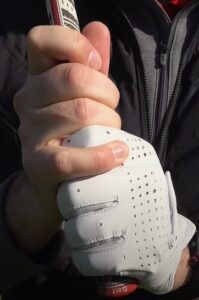
- Take the club handle in the left hand with the fingers wrapped around the handle.
- Place the right hand on the club handle with the little finger of the right hand placed between the index and middle fingers of the left hand.
- Wrap the fingers of the right hand around the club handle, overlapping the left hand.
- Make sure the hands are evenly spaced and positioned correctly on the club handle.
- Apply the desired grip pressure.
Interlocking Grip

- Take the club handle in the left hand with the fingers wrapped around the handle.
- Place the right hand on the club handle with the little finger of the right hand interlocking with the index finger of the left hand.
- Wrap the fingers of the right hand around the club handle, interlocking with the left hand.
- Make sure the hands are evenly spaced and positioned correctly on the club handle.
- Apply the desired grip pressure.
Baseball Grip
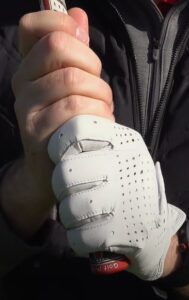
- Take the club handle in the left hand with the fingers wrapped around the handle.
- Place the right hand on the club handle with the fingers of the right hand touching but not overlapping the fingers of the left hand.
- Make sure the hands are evenly spaced and positioned correctly on the club handle.
- Apply the desired grip pressure.
Ten Finger (also known as the “baseball” or “hammer” grip)

- Take the club handle in both hands, with each hand positioned at the end of the handle.
- Wrap the fingers of both hands around the handle, with the little finger of each hand touching but not overlapping.
- Make sure both hands are evenly spaced and positioned correctly on the club handle.
- Apply the desired grip pressure.
Common mistakes to avoid
- Gripping the club too tightly: Over-gripping can lead to tension in the arms and hands, which can negatively impact the swing.
- Incorrect hand placement: The hands should be positioned evenly on the club handle and spaced correctly for maximum control.
- Holding the club too low or too high on the handle: This can impact the swing plane and lead to inconsistent shots.
- Not paying attention to the thumb position: The thumb should be positioned correctly on the club handle to allow for proper hand rotation during the swing.
- Not adjusting the grip for different clubs: The grip should be adjusted for different clubs, such as using a stronger grip for drivers and a weaker grip for short irons.
Importance of grip consistency
- Consistent Swing Plane: A consistent grip helps to ensure a consistent swing plane, which is the path that the club takes through the air. This leads to more accurate shots and improved performance.
- Improved Accuracy: When you have a consistent grip, it’s easier to repeat your swing and achieve consistent ball flight. This leads to improved accuracy and a more reliable game.
- Better Control: With a consistent grip, you’ll have better control over the club and be able to make more precise shots. This is especially important when playing in windy conditions or when trying to hit delicate shots around the greens.
- Reduced Tension: Consistent grip helps to reduce tension in the hands, arms, and body, leading to a more relaxed swing and improved overall performance.
Benefits of a Proper Golf Grip
Improved accuracy
A proper grip helps to ensure a consistent swing plane, leading to more accurate shots and improved performance.
Increased power
A proper grip allows for a more efficient transfer of energy from the body to the clubhead, resulting in increased power and distance on your shots.
Better control
With a proper grip, you’ll have better control over the club and be able to make more precise shots, especially in challenging conditions like windy weather or around the greens.
Reduced risk of injury
A proper grip helps to reduce tension in the hands, arms, and body, reducing the risk of injury and allowing for a smoother, more relaxed swing.
Improved confidence
When you have a proper grip, you’ll feel more confident and in control on the course, leading to improved performance and a more enjoyable experience.
Final Thoughts
A proper golf grip can greatly impact your game and lead to improved accuracy, greater power, increased control, and better overall performance.
Understanding the anatomy of the grip and different types of grips, along with experimenting and practicing regularly, can help you find the right grip that feels comfortable and secure.
Whether you’re a beginner or an experienced golfer, focusing on proper grip technique is essential for taking your game to the next level and avoiding injury.
So, remember to focus on comfort, grip pressure, hand size, and seek the advice of a professional, and most importantly, have fun out on the course!
Frequently Asked Questions:
What is a proper golf grip?
A proper golf grip is the way you hold the club to control the direction and trajectory of your shots. It involves placing your hands on the club in a specific manner that allows for maximum control and comfort.
Why is a proper golf grip important?
A proper golf grip is essential for a consistent golf swing and accurate shots. A good grip allows for proper wrist action and control of the clubface, which affects the direction and trajectory of your shots.
What is the proper way to grip a golf club?
The most common grip used in golf is the “Vardon grip”, named after Harry Vardon. It involves placing your left hand on the club with the V shape formed by your thumb and forefinger pointing towards your right shoulder. Your right hand should then grip the club with the V shape pointing towards your right ear.
How do I adjust my grip if I slice the ball?
If you slice the ball, it could be a sign of a weak grip. To correct this, try rotating your right hand more clockwise so that the V shape formed by your right hand points more towards your right shoulder.
How tight should I grip the club?
Your grip should be firm but relaxed. You should be able to hold the club comfortably and not feel tension in your hands or arms.
Can a poor grip affect my swing?
Yes, a poor grip can have a significant impact on your swing and the direction of your shots. It is important to have a proper grip to have a consistent and accurate swing.
Also See
Hi! I am Hannah, a golf enthusiast, have been perfecting my swing for over a decade, making long putts a breeze. Aside from playing, I am a professional golf writer, I try capture the nuances of the game and inspire others to embrace their love for golf. Follow me on Twitter.

